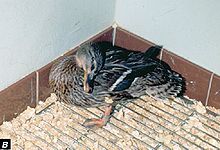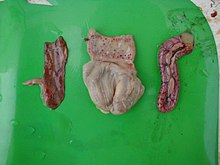Newcastle disease

The Newcastle disease ( Engl. : Newcastle Disease ( ND ) or pseudo Fowlpest ) is a common worldwide, extremely contagious and notifiable viral disease of birds. The clinical picture is reminiscent of avian influenza ("avian flu"), which is why Newcastle disease is also referred to as atypical avian influenza among experts . The disease was first detected in Europe in 1927 in Newcastle upon Tyne .
Pathogen
The Newcastle disease virus (NDV), a single (-) - strand RNA virus ( ss (-) RNA ) of the Paramyxoviridae family and the genus Avulavirus newly created in 2001 for NDV, is the causative agent of Newcastle disease . The NDV is closely related to the pathogen causing the paramyxovirus . Originally, the NDV was assigned to the genus Rubulavirus , which also includes the pathogens causing mumps in humans and kennel coughs in dogs.
Mainly chickens and turkeys of all age groups suffer from NDV, but occasionally also pigeons , geese , ducks , pheasants , partridges , quails and ostriches . The disease can also occur in penguins , ravens , parrots and canaries . In humans, the viruses cause conjunctivitis in individual cases .
Transmission routes
Infected animals excrete the Newcastle virus in large quantities in the faeces, body fluids, nasal, throat and eye secretions and breath. The pathogens can therefore spread directly from animal to animal as well as through the air, and also through eggs, fresh and frozen meat and dried eggs. The viruses can persist in frozen food for up to six months and in dry eggs for several years.
If infected, but not yet diseased animals, their eggs or meat products are transported, the viruses can also be carried through cages or packaging material. Stable dust that sticks to shoes, clothing or vehicle tires can also spread the virus from farm to farm.
Symptoms


The clinical picture of Newcastle disease initially shows numerous unspecific changes in the behavior and appearance of the animals, as they also occur with other acute infections:
- drastic decline in laying performance and thin-shelled to shell-less eggs
- high fever up to 43 ° C
- Apathy and loss of appetite
- watery, possibly bloody diarrhea
- Shortness of breath; The beak and eyes are covered with thick mucus
- Circulatory disorders, often with dark crest discoloration
- high mortality within five days of symptoms appearing
The incubation period is four to six days. If it spreads rapidly within the herd, deaths can occur without any previously recognizable symptoms.
The viruses attack the lungs , intestines and central nervous system and can u. a. cause punctiform bleeding on the lining of the stomach , especially around the ducts of the gastric glands.
In rare cases, people who are in close contact with sick animals can develop inflammation of the conjunctiva of the eye .
Combat
If a veterinary office detects Newcastle disease, a restricted area for poultry is usually set up within a radius of at least three kilometers. The poultry in this area must remain in the barn for three weeks on the instructions of the veterinary office to protect against the spread of the disease. Breeders must report their stocks. In addition, an observation area with a radius at least twice as large can be set up. Infected animals must be killed immediately. Affected stables, buildings and transport vehicles are disinfected. Additional restrictions on people and traffic may be imposed on keeping animals.
prevention
In Germany, the Avian influenza ordinance stipulates regular vaccination against Newcastle disease for every flock of chickens and turkeys. This also applies to private individuals who only keep a few chickens. The vaccination is usually done through the drinking water.
In Germany, chickens or turkeys may only be transferred from one poultry herd to another or exhibited at poultry markets, poultry shows and similar events if they are accompanied by a veterinary certificate stating that the herd of origin of the animals (in the case of day-old chicks, the Parent stock) has been regularly vaccinated against Newcastle disease.
vaccination
There are different strains used to vaccinate birds against Newcastle virus. These differ in their effect on the vaccinated animals:
- Avirulent: no disease from vaccination
- Lentogenic: low virulent, low mortality, decreased egg production
- Mesogenic: moderately virulent, mortality up to 50%, no egg production
- Velogenic: high virulence, serious illness with high mortality from vaccination.
For practical use, thermolability, i.e. the sensitivity of the vaccine strain to warming, for example due to the interruption of the cold chain during transport, is important. According to a publication by the FAO , the following virus strains are used for vaccination:
- F Lentogenic. Commonly used for young chicks, but can also be used for chickens of all ages.
- B1 Lentogenic. Slightly more virulent than strain F. Used as a vaccine for chickens of all ages
- La Sota Lentogenic. Often causes respiratory symptoms after vaccination. Is often used as a booster after a vaccination with strain F or strain B1.
- V4 Avirulent. Use for chickens of all ages
- V4-HR Avirulent. Thermostable, heat-resistant variant of Stamm V4. Suitable for chickens of all ages
- I-2 Avirulent. Also thermally stable, for chickens of all ages
- Mukteswar Mesogenic. An invasive strain used as a post-vaccination boost. May have side effects in the form of respiratory symptoms, weight loss, decreased egg production. Some animals die. Vaccination must be done by injection.
- Komarov Mesogenic. Slightly less pathogenic than the Mukteswar strain. Use as a boost. The vaccine must be injected.
The Newcastle virus in cancer therapy
Attempts have been made for some years to cure tumor diseases by infecting patients with special viruses that selectively kill tumor cells. Even if none of these methods have been approved for use on humans so far, the results so far raise hopes. In 1999, promising results were obtained in cancer patients with an attenuated strain of Newcastle virus, code-named MTH-68. Apparently, the virus preferentially attacks various tumor cells and multiplies in them, while leaving normal body cells almost untouched. In 2006, Hebrew University scientists were successful in isolating a variant of the Newcastle virus, code-named NDV-HUJ. They treated 14 patients with glioblastoma and rated the results as promising. In 2011, researchers at Memorial Sloan-Kettering Cancer Center and the Icahn School of Medicine at Mount Sinai modified the Newcastle virus with the viral protein NS1. This modified virus multiplied in cancer cells which overexpressed the anti-apoptotic factor Bcl-xL. The prevention of apoptosis, for example by Bcl-Xl, is an essential mechanism in the development of tumor diseases and could enable the selective control of tumor cells.
Web links
- Ordinance on protection against avian influenza and Newcastle disease (avian influenza ordinance) ( BGBl. 2004 I p. 2746 ) (old version of November 3, 2004; PDF; 109 kB)
Individual evidence
- ↑ Notifiable animal diseases. In: bmel.de. Federal Ministry of Food and Agriculture , accessed on January 3, 2016 .
- ↑ DL Alexander: Newcastle disease, Newcastle disease virus - an avian paramyxovirus. Kluwer Academic Publishers, Dordrecht, The Netherlands 1988, pp. 1-22 .
- ^ Federal Food Safety and Veterinary Office of Switzerland on Newcastle Disease. Retrieved November 20, 2017
- ↑ PB SPRADBROW, AL IBRAHIM, A MUSTAFFA-BABJEE, SJ KIM: Use of an avirulent Australian strain of Newcastle Disease Virus as vaccine. In: Avian Diseases . tape 22 , no. 2 , 1978, p. 329-335 .
- ^ Food and Agriculture Organization of the United Nations., FAO Regional Office for Asia and the Pacific .: A Basic laboratory manual for the small-scale production and testing of 1-2 Newcastle disease vaccine . FAO Regional Office for Asia and the Pacific (RAP), Bangkok 2002, ISBN 978-974-7946-26-0 .
- ↑ LK Csatary, RW Moss, J. Beuth, B. Töröcsik, J. Szeberenyi, T. Bakacs: Beneficial treatment of patients with advanced cancer using a Newcastle disease virus vaccine (MTH-68 / H). In: Anticancer Research . 19 (1B), 1999, pp. 635-638 , PMID 10216468 .
- ↑ LaszloK Csatary: VIRUSES IN THE TREATMENT OF CANCER . In: The Lancet . tape 298 , no. 7728 , October 1971, p. 825 , doi : 10.1016 / S0140-6736 (71) 92788-7 ( elsevier.com [accessed June 23, 2020]).
- ↑ Viruses: The new cancer hunters (source no longer available). March 1, 2006, accessed March 1, 2006 .
- ↑ M. Mansour, P. Palese, D. Zamarin: Oncolytic Specificity of Newcastle Disease Virus Is Mediated by Selectivity for Apoptosis-Resistant Cells . In: Journal of Virology . tape 85 , no. 12 , June 15, 2011, ISSN 0022-538X , p. 6015–6023 , doi : 10.1128 / JVI.01537-10 , PMID 21471241 , PMC 3126310 (free full text) - ( asm.org [accessed June 23, 2020]).